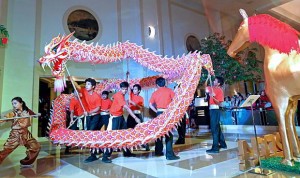
PAINTING THE TOWN RED. A dragon dance troupe performs at the lobby of the Waterfront Hotel as part of the Chinese New Year celebration. According to Oriental beliefs, the dance is meant to ward off evil spirits. (CDN PHOTO/JUNJIE MENDOZA)
Asked about their plans for celebrating today’s Chinese New Year, several Chinese business leaders replied that they would have family dinner complete with the traditional trimmings.
“During the New Year’s Eve, my family and I will just have a simple dinner together in one of the restaurants. I will also distribute Ang Pao to my children and grandchildren,” said Joe Ng, Philippine Chamber of Commerce and Industry Inc. (PCCI) representative for the Visayas.
Ng said tradition in China dictates that the family celebrate the New Year by gathering every family member to dine together called “Wei Lu.”
“Everyone in the family gathers around the hot pot (shabu shabu) where a wide variety of food like meat balls, beef balls, fish balls, pumpkin cakes, raddish cakes, rice cakes and tikoy,” Ng said.
He said each food represents different types of luck or wishes.
After the dinner, Ng said the elders will start distributing ‘Ang Pao’ with cash placed inside red envelopes followed by watching the fireworks outside the home.
“On the following morning, before the sun rises, the Buddhists will visit every Chinese temple to offer the first incense stick, since they believe that the Heaven Gate is open before dawn on the first day (New Year) of Lunar Calendar,” Ng said.
Other business leaders like Eric Ng Mendoza, former president of the Mandaue Chamber of Commerce and Industry, also said they will follow tradition and spend dinner with their families.
“We will have three round table family dinner gathering with my mother, my four brothers and a sister and spouses on January 30 together with our children,” Mendoza said.
He said they usually serve traditional Chinese dishes like Chinese lumpia with lots of condiments like sweet grounded peanuts plus fried tikoy.
On the table they usually place a traditional kettle surrounded with kiat oranges and angpao red envelopes to be distributed after dinner.
Melanie Ng, Philippine Retailers Association Cebu chapter chairperson, said it’s a tradition to prepare fresh Chinese lumpia (rolls) to welcome the New Year for their family.
“We also eat lots of sweet and sticky food for prosperity and good luck in the coming year. Oranges are also abundant in the new year because this represents prosperity and abundance,” she said.
Younger generation Chinese Cebuanos like Jaja Chiongbian Rama, Kaye Luym, Steven Kokseng and Rere Dakay also celebrate the Chinese New Year with the family.
“It’s usually a feast – noodles, steamed lapu-lapu with soy-ginger sauce, my grandmother’s special lumpia which she mixes with bamboo shoots and lechon for the meat-eaters,” Luym said.
Steven Kokseng, whose family started Dimsum Break in Cebu, said they usually have a mix of traditional Chinese dishes like Chinese lumpia, noodles and others.
“Also, round fruits like oranges are usually present at the table,” he said. Rama said they have no definite plans yet.
“We usually get-together as a family for dinner with our grandmother,” Rama said.
Rere Dakay agreed, saying they have dinner in their home and serve tikoy.